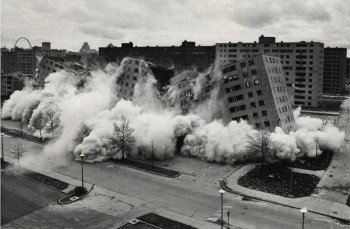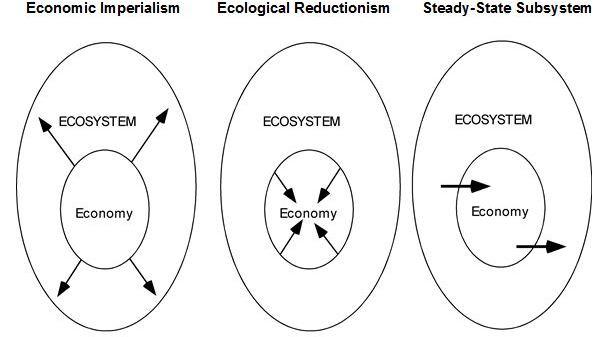Slumlord Nation
by Eric Zencey
 According to architectural critic Charles Jencks, modern architecture died forty one years ago, on March 16, 1972. That’s the day that dynamite charges brought down the first of the Pruitt-Igoe public housing towers in St. Louis, Missouri. You’ve probably seen the pictures: a cloud of dust swirls out into the street while the tops of the buildings, still square, sag and tilt crazily. The photo captures rectilinear form giving way to dust and rubble: an iconic moment, an image that reminds us that entropy — the law of increasing disorder — haunts all our acts and works. In the distance you can make out another St. Louis icon, Eero Saarinen’s Gateway Arch, that gleaming stainless steel monument to the city’s role as mustering yard for the nation’s western expansion.
According to architectural critic Charles Jencks, modern architecture died forty one years ago, on March 16, 1972. That’s the day that dynamite charges brought down the first of the Pruitt-Igoe public housing towers in St. Louis, Missouri. You’ve probably seen the pictures: a cloud of dust swirls out into the street while the tops of the buildings, still square, sag and tilt crazily. The photo captures rectilinear form giving way to dust and rubble: an iconic moment, an image that reminds us that entropy — the law of increasing disorder — haunts all our acts and works. In the distance you can make out another St. Louis icon, Eero Saarinen’s Gateway Arch, that gleaming stainless steel monument to the city’s role as mustering yard for the nation’s western expansion.
Jencks was wrong about modern architecture. So are those who blamed the residents of Pruitt-Igoe for the buildings’ decay and destruction. What brought those buildings down is a dynamic that’s very familiar in our modern economies — a dynamic that the conceptual lens of ecological economics lets us understand very clearly.
Pruitt-Igoe was a federally funded urban renewal project comprised of thirty-three high-rise apartment buildings, eleven stories each, on a 57-acre plot. It represented the best design practices for high-density urban development when it was built. It had green space (a benefit of building up instead of out). It had community function rooms on the ground floors and every third floor (which is where the novel, skip-stop elevators went, encouraging residents to think of every three floors as a neighborhood, since they’d pass and meet in stairwells). Within the limits of Missouri law, it was desegregated. The Pruitt towers, named for a black WWII aviator from Missouri, were for blacks, and the Igoe towers, named for a white Congressman, were for whites. The whole complex was designed for mixed incomes. Some apartments were rented at market rates to middle class families; others were subsidized, with rent limited to a percentage of household income. (Under welfare rules, these apartments could not have telephones or televisions and were available only to families that did not have an able-bodied wage-earner in the household.)
New and ultra-modern when they were built in the early 1950s, after less than two decades’ use the buildings had become a filthy, crime-infested, broken-windowed, high-rise slum, as bad as (and in many ways worse) than the housing they had been built to replace. In desperation the St. Louis Housing Authority consolidated the remaining tenants into a few buildings and demolished the others. The attempt at retrenchment failed. By 1976 the last remaining tenants had been relocated, the buildings razed, the site bulldozed. Today the acreage holds a couple of schools and the country’s largest accidental urban forest.
What brought the towers down, says one conventional (and racist) narrative, was the behavior of its residents. Despite the plan for a mix of income groups and separate-but-close mingling of races, the towers soon held just low-income African Americans, and they were responsible for trashing the buildings. The architect, Minoru Yamasaki (who went on to design the World Trade Center Towers, which came down under very different circumstances) gave credence to this interpretation when he allowed, “I never thought people were that destructive.” A slightly less racist version of this narrative notes that adolescent boys are always the prime perpetrators of vandalism, and that welfare regulations had the unintended effect of breaking up families, ensuring that quite a few adolescent males in the complex had no father figure at home. Vandalism and crime were the predictable result.
A different conventional narrative is told by some architectural critics, like Jencks, who find that the building themselves were at fault. The projects were too massive, too anonymous, too soulless to be successful in fostering neighborliness and a shared sense of pride in place. The public spaces of the complex, this theory says, became no-man’s-lands that residents avoided and hurried through. With no one caring for them, they fell into disrepair and bred crime, vandalism, trash, brutality.
Neither of those narratives comes anywhere close to capturing the complex truth, which is that the Pruitt-Igoe towers were brought down by an unfortunate collision of factors. Federal funding paid for construction, but operating costs were the responsibility of the city. The intended occupancy rate would have enabled rental income to cover these. But the population of St. Louis was undergoing an historic change; it fell from 857,000 to 622,000 between 1950 and 1970. Some of this was a general postwar exodus to the suburbs, fuelled by cheap gas, Veterans Administration mortgages, and the assembly-line methods of suburban construction pioneered in Levittown. Some — a great part of it — was white flight. In 1954 the Brown v. Board of Education of Topeka decision mandated the desegregation of public schools, and two years later a Missouri court ordered desegregation of public housing in the city. Middle-class whites left St. Louis for the suburbs, where housing costs and racial discrimination in sales and rentals — “redlining” — would preserve segregated schools for decades to come. With its middle-income apartments emptying and being re-let to impoverished black families, the Housing Authority could no longer support Pruitt-Igoe’s maintenance expenses.
The slum housing that Pruitt-Igoe replaced had become degraded and unhealthy for sound economic reasons. A slumlord maximizes his income stream by zeroing out maintenance costs, consuming the stored integrity of a building as income, and letting the building depreciate down to nothing. Tax law, which allows deductions for depreciation, makes this an even more lucrative strategy. Faced with an inadequate income stream, the public housing authority of St. Louis did what slumlords do: they reduced their budget gap by zeroing out maintenance expenses and sucking the integrity and usefulness out of their property.

The Pruitt-Igoe demolition offers a clear warning about resorting to the slumlord model (credit: St. Louis Post Dispatch).
As any businessman can tell you, if your operation can’t afford routine maintenance of its productive assets, your operation is in deep trouble. What you’ve got then isn’t a business plan but a plan to be a parasite.
Nature knows three kinds of parasites. One lives in a symbiotic relationship with its host, never diverting so much of the host’s life-energy as to constitute a threat to its continued well-being. (You don’t even notice the mites that live on your dead skin cells.) Another kind of parasite flourishes by consuming its host to death; like smallpox or the plague, it destroys what it feeds on and then jumps to another host. A third kind of parasite falls in between. It sucks a considerable amount of life from the host but doesn’t actually kill it; it achieves a kind of equilibrium, imposing a degraded and diminished life on its host. Tapeworms fall into this category, along with some chronic diseases, such as leprosy, malaria, and tuberculosis. Call it the slumlord model: sustainable, under certain conditions.
Unlike the things humans build, ecosystems (and, by and large, individual organisms within them) are capable of a high degree of self-repair. Any act of maintenance involves resisting entropic decline in a system by importing matter, energy, and design intelligence into a system to restore a valued and orderly arrangement. Broken windows don’t fix themselves. For that you need new glass and a glazier to install it. But damaged ecosystems do repair themselves, if they haven’t been degraded beyond recovery: they use physical nutrients, solar throughput, and the design intelligence of evolution to maintain and deepen their systems of orderly relations.
In his 1952 classic Soil and Civilization, Edward Hyams pointed out that humans have always been parasites on their host ecosystems. We divert some of the resource-energy of those systems and channel it through our bodies and societies before exhausting it, degraded, back into the host. Many, even most hunter-gatherer tribes lived in symbiotic relationship with ecosystems, colonizing part of nature’s food-energy flow but rarely threatening the integrity and continued life of the system as a whole. As agriculturalists, humans sometimes lived in balance with the soil community, never extracting more of its energy-fertility than the system could rebuild from annual solar inflow. But some agricultural societies mined their soil fertility, drawing it down faster than it could be replenished. They consumed the maintenance-energy of their host soils, and either jumped to another host or disappeared as their once-fertile land became sterile sand and gravel.
Today, the bulk of humanity functions as hydrocarbon-fueled industrial parasites — life-suckers whose ambitions include not just food security and reproduction but the accumulation of great material wealth. To gratify those ambitions we’ve used the stored capital of the planet (a finite stock of fossil fuels) to increase the rate at which we suck the maintenance out of planetary ecosystems. We’ve become a slumlord species: we cash out nature’s maintenance flows and spend our gains as income.
Symbiotic parasitism, which allows the host to flourish, is the only one of these roles that will give us an ecologically sustainable economy with a relatively high standard of living. The find-another-host strategy is clearly out: we’ve only got one planet, and we’ve built out to the edge of its capacity to hold us. The slumlord strategy won’t work, either. The typical slumlord doesn’t have to live in the slum that his self-interested behavior creates; his home is somewhere else. On a fully developed, fully occupied planet, there is no “somewhere else.”
Once upon a time, when the world held fewer humans, it seemed that there was room in it for slumlord parasitism. Saarinen’s Gateway Arch memorializes an epic transit, the opening of the American West, and it’s fitting that you can see it on the distant horizon in those iconic pictures of the Pruitt-Igoe demolition. Whatever else it memorializes, the Arch also marks the transit of a parasitic species looking for a new host, migrating in search of fresh ecosystems whose stocks of capital and maintenance energy could be sucked down, cashed out and spent as current income.
Eventually some humans learned that we ought not to turn our own environmental neighborhood into a slum. Many developed nations passed laws — in the U.S. there was the Clean Air Act, the Endangered Species Act, the Water Pollution Control Act — to ensure that we didn’t completely zero out the maintenance of the ecosystems that support us. But like slumlords comfortably housed in the suburbs, those in the industrialized countries continued to benefit from the draw-down of maintenance elsewhere in the system. Mostly we who live in the United States exported our damage to the undeveloped and less developed nations of the world, places willing to sacrifice natural capital and ecosystem integrity to the promise — not always fulfilled — of economic gain.
In St. Louis, slumlording depended on the existence of a class of renters who had no other choices: poverty and racism held African Americans in place, in housing that no one should have to endure. In the world at large, our slumlord practice is maintained by the dogmas of infinite-planet economics. We rely on the ideology of free trade, and the spurious argument that environmental quality is a luxury good, to tell the impoverished citizens of the world that if they’re patient enough and smart enough, they will someday live as we do — as if a political economy in which 5% of the world’s population uses 25% of the world’s resource flow could be expanded to include everyone. But there is just enough material progress to make the dogmas seem accurate: thanks to frantic expansion of the matter-and-energy stream that humans suck out of the planet, and to a decline in the U.S. share of that stream as its middle class disappears, once-poor countries like China and India are developing their own middle class consumerist economies. Meanwhile, our planetary habitation is being damaged and degraded even more rapidly. To most of us, in most places it looks okay, but that’s because we haven’t been schooled in the understanding we need in order to see the damage. Our ecological ignorance allows us to ignore the fact that we’re sucking the life-maintenance out of the planet.
The fate of the Pruitt-Igoe towers shows us the likely outcome of continuing to do that.
—
Eric Zencey is a Fellow of the Gund Institute for Ecological Economics at the University of Vermont and also teaches in the Graduate Architecture and Urban Planning programs at Washington University in St. Louis. He is the author most recently of Greening Vermont: The Search for a Sustainable State and The Other Road to Serfdom and the Path to Sustainable Democracy.



Thank you, excellent analogy.
This is a very eloquent piece of writing that displays common sense and ecological and evolutionary literacy. It astounds me that our society (including economists) remains with their heads stuck in the sand when these ideas seem to be so simple and basic, especially when they are so well articulated as this article is.
On a different note perhaps, Dr. Zencey might give Dr. Daly a tutorial on evolutionary theory.
Point being there is infinite wisdom out there, such as this site and the quotes below, and we need to elevate those that place Earth and its species ahead of profits into positions of decision-making until we can 86 these odious hierarchical destructive paradigms in use today and replace them, via real education systems and not corporate indoctrination camps we nefariously refer to as “higher education”, with consensus-decision making models. Most, if not, ALL contemporary man-made institutions need to be neutralized and eliminated. Having difficulty with this notion, well wrap your head around The Story of Stuff and you get the hint.
“language is never neutral” ― Paulo Freire
“Washing one’s hands of the conflict between the powerful and the powerless means to side with the powerful, not to be neutral. ” ― Paulo Freire
“Education either functions as an instrument which is used to facilitate integration of the younger generation into the logic of the present system and bring about conformity or it becomes the practice of freedom, the means by which men and women deal critically and creatively with reality and discover how to participate in the transformation of their world.” ― Paulo Freire, Pedagogy of the Oppressed